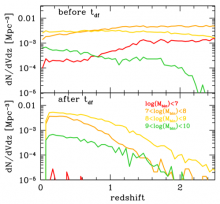
Abstract
Distinguishing the photon output of an accreting supermassive black hole binary system from that of a single supermassive black hole accreting at the same rate is intrinsically difficult because the majority of the light emerges from near the innermost stable orbits of the black holes. However, there are two possible signals that can distinctively mark binaries, both arising from the gap formed in circumbinary accretion flows inside approximately twice the binary separation. One of these is a "notch" cut into the thermal spectra of these systems in the IR/optical/UV, the other a periodically varying excess hard X-ray luminosity whose period is of order the binary orbital period. Using data from detailed galaxy evolution simulations, we estimate the distribution function in mass, mass ratio, and accretion rate for accreting supermassive binary black holes (SMBBHs) as a function of redshift and then transform this distribution function into predicted source counts for these two potential signals. At flux levels ![]() 10−13 erg cm−2 s−1, there may be ~O(102) such systems in the sky, mostly in the redshift range 0.5
10−13 erg cm−2 s−1, there may be ~O(102) such systems in the sky, mostly in the redshift range 0.5 ![]() z
z ![]() 1. Roughly 10% should have periods short enough (
1. Roughly 10% should have periods short enough (![]() 5 yr) to detect the X-ray modulation; this is also the period range accessible to Pulsar Timing Array observations.
5 yr) to detect the X-ray modulation; this is also the period range accessible to Pulsar Timing Array observations.